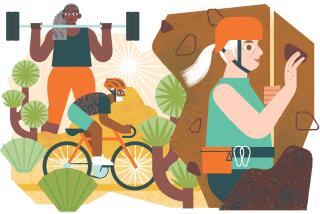Tai Chi Puts Accent on Strength Through Softness
- Share via
Donald Reddick just didn’t get it.
He’d signed up for an exercise class, and here was his instructor “talking about energy flowing through the body. And I thought, ‘What IS this nonsense?’ ”
That was four years ago, and Reddick has long since decided it wasn’t nonsense after all. He stuck with it and is now an advanced student of tai chi chuan, a combination of exercise, philosophy, meditation and martial arts developed thousands of years ago by Chinese monks.
“It isn’t like sticking your finger in a light socket or anything,” explains tai chi chuan instructor Valarie Prince of Corona del Mar, who teaches for the Laguna Beach Parks and Recreation Department (where Reddick is a student), as well as Orange Coast College and Irvine Valley Community College Community Services. “Having energy flowing through your body is just, well, you know when you’re having a really good day and you’re happy and you feel good about your life? That’s when you have a good flow of energy.”
Reddick decided to try tai chi chuan--often called simply tai chi--because with other forms of exercise, “I’d feel just as stressed out after I did them as I did before I started. And I was looking for some exercise that wasn’t damaging to the body.”
The Chinese words tai chi chuan translate into “supreme ultimate boxing” or “supreme ultimate exercise,” Prince says. Her favorite definition of the art goes a bit further: “Supreme ultimate exercise of self-control in any given situation.”
She and other experienced practitioners of the art say the exercise makes them stronger and more flexible in all aspects of their lives, not just physically.
“It’s a life philosophy, really,” says Bogdan Kulminski, an intermediate student in Laguna Beach who started studying two years ago with his wife, Diane. “We wanted something we could do together, and this has worked out really well. And it’s helped my basketball shot, too, because I’m able to concentrate much better.”
To an observer more familiar with aerobics and other Western methods, tai chi may not even appear to be exercise at all at first glance. The exercise begins with stationary positions that emphasize breathing and stretching, followed by a series of very specific movements with colorful names such as “Step Back and Repulse Monkey” and “Wave Hands Like Clouds.”
In the style Prince teaches (Kuang Ping style), there are 64 such movements, while in the more widely practiced Yang style, there are 24 in the short form and 82 in the long form.
At times, tai chi practitioners move so slowly they look more like statues, but at other times they move quickly, with swift kicks toward an imaginary opponent.
Unlike Western exercises that build “hard bodies,” tai chi emphasizes strength with softness. Even moves that require standing on one foot for as long as 30 minutes build muscle tone, Prince says, as her students can attest.
“Instead of ‘no pain, no gain,’ in tai chi chuan it’s more a matter of ‘move it or lose it.’ It keeps you loose and flexible,” she says. “This has more of an impact on how you feel than how you look, and I think a lot of people get into exercise for the wrong reason, because they want to look good. Well, I want to look good in my jeans, too, but how I feel is more important.”
For Prince, tai chi is the perfect antidote for the stresses of life in Orange County. “Everything moves so fast here, and there’s so much pressure. This is basically a reprieve from all that. You just let go.
“The tighter you get, the harder it is to live. But the freer and looser you are, the closer you are to life. It’s just like blood vessels that are constricted because of tension or blocked with fat; the blood can’t flow through them as easily. It’s the same with energy--if you’re tense and tight, it won’t flow as well.
“I’m not promising that if you take tai chi there won’t be stress in your life,” she says. “But it gives you a place you can go to, inside yourself, to relax. By controlling the way you move, you can control the way you feel.”
As a martial art of the “soft fist” school (there is also a “hard fist,” made popular by kung fu movies), tai chi chuan stresses yielding and deflecting blows rather than using direct force. “It’s like water,” Prince says. “Water was strong enough to cut the Grand Canyon. But it’s a very soft substance.”
Prince started studying tai chi almost by accident 12 years ago. Because she wanted to put her daughter, now 16, in the day-care center at Orange Coast College, she enrolled for a few classes, including a tai chi class, to qualify for student status.
“The first semester, I thought it was a little weird,” she says. “I wasn’t even sure why I came back for the next class. But then I remember I was doing the form out in my back yard one day, and all of a sudden, I knew I was doing it right. I got such a feeling of joy and calm that I decided to keep doing it.”
She became a teacher eight years ago, and now has gone on to other tai chi-related forms of exercise, including push-hands, a form practiced by two people.
“The bottom line is, it makes ME feel good,” she says. “I wanted to share that with other people.”
“Tai chi has been around for a couple thousand years, and for about 400 years in its current form,” she says. “There must be something to it or it wouldn’t have lasted so long. It isn’t a fad.”


